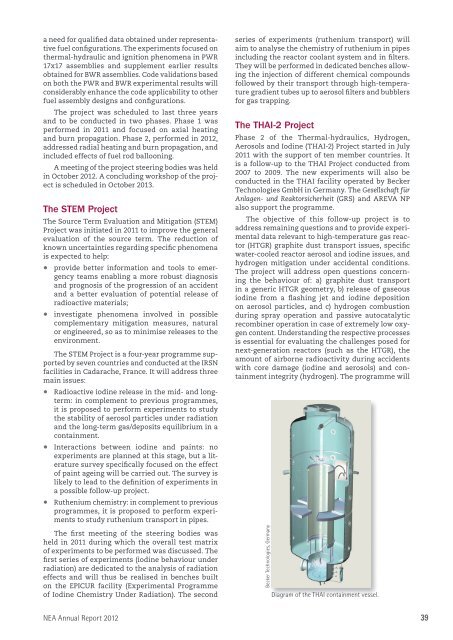Download the report in pdf format - OECD Nuclear Energy Agency
Download the report in pdf format - OECD Nuclear Energy Agency
Download the report in pdf format - OECD Nuclear Energy Agency
You also want an ePaper? Increase the reach of your titles
YUMPU automatically turns print PDFs into web optimized ePapers that Google loves.
a need for qualified data obta<strong>in</strong>ed under representative<br />
fuel configurations. The experiments focused on<br />
<strong>the</strong>rmal-hydraulic and ignition phenomena <strong>in</strong> PWR<br />
17x17 assemblies and supplement earlier results<br />
obta<strong>in</strong>ed for BWR assemblies. Code validations based<br />
on both <strong>the</strong> PWR and BWR experimental results will<br />
considerably enhance <strong>the</strong> code applicability to o<strong>the</strong>r<br />
fuel assembly designs and configurations.<br />
The project was scheduled to last three years<br />
and to be conducted <strong>in</strong> two phases. Phase 1 was<br />
performed <strong>in</strong> 2011 and focused on axial heat<strong>in</strong>g<br />
and burn propagation. Phase 2, performed <strong>in</strong> 2012,<br />
addressed radial heat<strong>in</strong>g and burn propagation, and<br />
<strong>in</strong>cluded effects of fuel rod balloon<strong>in</strong>g.<br />
A meet<strong>in</strong>g of <strong>the</strong> project steer<strong>in</strong>g bodies was held<br />
<strong>in</strong> October 2012. A conclud<strong>in</strong>g workshop of <strong>the</strong> project<br />
is scheduled <strong>in</strong> October 2013.<br />
The STEM Project<br />
The Source Term Evaluation and Mitigation (STEM)<br />
Project was <strong>in</strong>itiated <strong>in</strong> 2011 to improve <strong>the</strong> general<br />
evaluation of <strong>the</strong> source term. The reduction of<br />
known uncerta<strong>in</strong>ties regard<strong>in</strong>g specific phenomena<br />
is expected to help:<br />
• provide better <strong>in</strong><strong>format</strong>ion and tools to emergency<br />
teams enabl<strong>in</strong>g a more robust diagnosis<br />
and prognosis of <strong>the</strong> progression of an accident<br />
and a better evaluation of potential release of<br />
radioactive materials;<br />
• <strong>in</strong>vestigate phenomena <strong>in</strong>volved <strong>in</strong> possible<br />
complementary mitigation measures, natural<br />
or eng<strong>in</strong>eered, so as to m<strong>in</strong>imise releases to <strong>the</strong><br />
environment.<br />
The STEM Project is a four-year programme supported<br />
by seven countries and conducted at <strong>the</strong> IRSN<br />
facilities <strong>in</strong> Cadarache, France. It will address three<br />
ma<strong>in</strong> issues:<br />
• Radioactive iod<strong>in</strong>e release <strong>in</strong> <strong>the</strong> mid- and longterm:<br />
<strong>in</strong> complement to previous programmes,<br />
it is proposed to perform experiments to study<br />
<strong>the</strong> stability of aerosol particles under radiation<br />
and <strong>the</strong> long-term gas/deposits equilibrium <strong>in</strong> a<br />
conta<strong>in</strong>ment.<br />
• Interactions between iod<strong>in</strong>e and pa<strong>in</strong>ts: no<br />
experiments are planned at this stage, but a literature<br />
survey specifically focused on <strong>the</strong> effect<br />
of pa<strong>in</strong>t age<strong>in</strong>g will be carried out. The survey is<br />
likely to lead to <strong>the</strong> def<strong>in</strong>ition of experiments <strong>in</strong><br />
a possible follow-up project.<br />
• Ru<strong>the</strong>nium chemistry: <strong>in</strong> complement to previous<br />
programmes, it is proposed to perform experiments<br />
to study ru<strong>the</strong>nium transport <strong>in</strong> pipes.<br />
The first meet<strong>in</strong>g of <strong>the</strong> steer<strong>in</strong>g bodies was<br />
held <strong>in</strong> 2011 dur<strong>in</strong>g which <strong>the</strong> overall test matrix<br />
of experiments to be performed was discussed. The<br />
first series of experiments (iod<strong>in</strong>e behaviour under<br />
radiation) are dedicated to <strong>the</strong> analysis of radiation<br />
effects and will thus be realised <strong>in</strong> benches built<br />
on <strong>the</strong> EPICUR facility (Experimental Programme<br />
of Iod<strong>in</strong>e Chemistry Under Radiation). The second<br />
series of experiments (ru<strong>the</strong>nium transport) will<br />
aim to analyse <strong>the</strong> chemistry of ru<strong>the</strong>nium <strong>in</strong> pipes<br />
<strong>in</strong>clud<strong>in</strong>g <strong>the</strong> reactor coolant system and <strong>in</strong> filters.<br />
They will be performed <strong>in</strong> dedicated benches allow<strong>in</strong>g<br />
<strong>the</strong> <strong>in</strong>jection of different chemical compounds<br />
followed by <strong>the</strong>ir transport through high-temperature<br />
gradient tubes up to aerosol filters and bubblers<br />
for gas trapp<strong>in</strong>g.<br />
The THAI-2 Project<br />
Phase 2 of <strong>the</strong> Thermal-hydraulics, Hydrogen,<br />
Aerosols and Iod<strong>in</strong>e (THAI-2) Project started <strong>in</strong> July<br />
2011 with <strong>the</strong> support of ten member countries. It<br />
is a follow-up to <strong>the</strong> THAI Project conducted from<br />
2007 to 2009. The new experiments will also be<br />
conducted <strong>in</strong> <strong>the</strong> THAI facility operated by Becker<br />
Technologies GmbH <strong>in</strong> Germany. The Gesellschaft für<br />
Anlagen- und Reaktorsicherheit (GRS) and AREVA NP<br />
also support <strong>the</strong> programme.<br />
The objective of this follow-up project is to<br />
address rema<strong>in</strong><strong>in</strong>g questions and to provide experimental<br />
data relevant to high-temperature gas reactor<br />
(HTGR) graphite dust transport issues, specific<br />
water-cooled reactor aerosol and iod<strong>in</strong>e issues, and<br />
hydrogen mitigation under accidental conditions.<br />
The project will address open questions concern<strong>in</strong>g<br />
<strong>the</strong> behaviour of: a) graphite dust transport<br />
<strong>in</strong> a generic HTGR geometry, b) release of gaseous<br />
iod<strong>in</strong>e from a flash<strong>in</strong>g jet and iod<strong>in</strong>e deposition<br />
on aerosol particles, and c) hydrogen combustion<br />
dur<strong>in</strong>g spray operation and passive autocatalytic<br />
recomb<strong>in</strong>er operation <strong>in</strong> case of extremely low oxygen<br />
content. Understand<strong>in</strong>g <strong>the</strong> respective processes<br />
is essential for evaluat<strong>in</strong>g <strong>the</strong> challenges posed for<br />
next-generation reactors (such as <strong>the</strong> HTGR), <strong>the</strong><br />
amount of airborne radioactivity dur<strong>in</strong>g accidents<br />
with core damage (iod<strong>in</strong>e and aerosols) and conta<strong>in</strong>ment<br />
<strong>in</strong>tegrity (hydrogen). The programme will<br />
Becker Technologies, Germany<br />
Diagram of <strong>the</strong> THAI conta<strong>in</strong>ment vessel.<br />
NEA Annual Report 2012<br />
39
















